List of National Treasures of Japan (ancient documents)
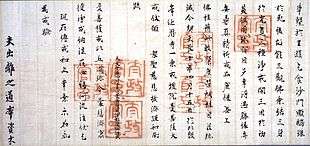
The term "National Treasure" has been used in Japan to denote cultural properties since 1897.[1][2] The definition and the criteria have changed since the introduction of the term. These ancient documents adhere to the current definition, and have been designated National Treasures since the Law for the Protection of Cultural Properties came into effect on June 9, 1951. The items are selected by the Agency for Cultural Affairs, a special body of the Ministry of Education, Culture, Sports, Science and Technology, based on their "especially high historical or artistic value".[3][4] "Ancient documents" is one of thirteen categories of National Treasures recognized by the agency. The list presents 60 documents or sets of documents from classical to early modern Japan, from the Asuka period to the Meiji period. The actual number of items is more than 60 because groups of related objects have been combined into single entries. The list contains items of various type such as letters, diaries, records or catalogues, certificates, imperial decrees, testaments and maps. The documents record early Japanese government and Buddhism including early Japanese contact with China, the organization of the state and life at the Japanese imperial court. They are housed in 14 Japanese cities in temples (35), museums (13), libraries or archives (5), shrines (3), universities (2) and in private collections (2). Most entries (28) in the list are located in Kyoto. The documents in this list were made predominantly with a writing brush on paper and, in many cases, present important examples of calligraphy.[4]
Writing was physically introduced to Japan from China in the form of inscribed artefacts at the beginning of the Christian era. Examples, some of which have been designated as archaeological National Treasures, include coins of the reign of Wang Mang (AD 8–25), a 1st-century gold seal from Shikanoshima, a late 2nd century iron sword from the Tōdaijiyama burial mound, the Seven-Branched Sword with inscription from 369 and a large number of bronze mirrors—the oldest dating to the 3rd century.[5][6][7] All of these artefacts originated on the continent, most likely in China. However, the written inscriptions on them may not have been recognized as writing but instead may have been mistaken for decorations by the Japanese.[5] When the Japanese later manufactured locally copies of original Chinese mirrors, they may have continued to believe the written inscriptions to be merely decorative.[8][9]
The concept of writing came to Japan from the Korean kingdom of Baekje in the form of classical Chinese books likely written on paper and in the form of manuscript rolls (kansubon).[5][10] This probably happened at the beginning of the 5th century (around 400), and certainly during the 6th century.[10][11] According to legend the scholar Wani introduced the Chinese writing system as well as Confucianism to Japan.[10] The oldest texts of Japanese origin, which show a clear understanding of the concept of writing, date to the 5th century and are—like most texts from before 700—inscriptions on stone or metal.[12] Examples include three archaeological National Treasures: Suda Hachiman Shrine Mirror from about the 5th century, which is a poor copy of a Chinese original, the Inariyama Sword from 471 or 531 and the Eta Funayama burial mound sword from about the 5th century.[13][14] The abrupt transition from an unfamiliarity with writing to reading and writing complicated works in a foreign language required the earliest Japanese texts be composed and read by people from the continent such as Wani.[10] The Inariyama Sword is also the oldest example of man'yōgana use, a writing system that employs Chinese characters to represent the Japanese language.[15] Soon after the introduction of writing, scribes were appointed to the provinces to "record events and report conditions".[16][17]
While writing in Japan was limited during the 5th and 6th centuries, the number of documents written locally increased in the 7th century; though most of them have been lost.[11][18] By the end of the 7th century increased cultural dependence on China caused reading and writing, particularly in government and religion, to become an integral part of Japanese life.[18] There were two major factors for this development: starting with the Taika Reforms (645–649) and continuing with the Asuka Kiyomihara Code (689) and censuses from 670 and 690, a Chinese style centralised state was formed, requiring the need for a large number of officials who were literate and educated in, among others, Confucian texts at the Daigakuryo ("University") founded under Emperor Tenchi.[18] The second factor was the increasing popularity of Buddhism, which had been introduced to Japan in the mid-6th century and strongly promoted by Prince Shōtoku (574–622).[18] The Sangyō Gisho ("Annotated Commentaries on the Three Sutras"), traditionally attributed to Prince Shōtoku, is the oldest extant Japanese text of any length.[19] Buddhism required the study of sutras written in Chinese and the state founded a Sutra Copying Bureau (shakyōjo) before 727.[nb 1][18] The oldest Japanese books are two chronicles, Kojiki and Nihon Shoki, from the early 8th century. While the phonogram orthography enjoyed increasing popularity during the 8th century, it was not yet used for longer prose. The modern kana, notably hiragana and katakana were developed in the Heian period.[20]
Statistics
Almost half of all entries in the list are located in Kyoto.
.png)
| Prefecture | City | National Treasures |
|---|---|---|
| Chiba | Sakura | 2 |
| Fukuoka | Fukuoka | 1 |
| Gifu | Motosu | 1 |
| Kyoto | Kyoto | 28 |
| Miyazu | 1 | |
| Nara | Nara | 3 |
| Osaka | Kawachinagano | 1 |
| Shimamoto | 1 | |
| Shiga | Ōtsu | 8 |
| Shizuoka | Makinohara | 1 |
| Tochigi | Ōtawara | 1 |
| Tokyo | Tokyo | 10 |
| Wakayama | Kōya | 1 |
| Yamagata | Yonezawa | 1 |
| Period[nb 2] | National Treasures |
|---|---|
| Asuka period | 1 |
| Nara period | 7 |
| Heian period | 32 |
| Tang Dynasty | 1 |
| Kamakura period | 16 |
| Yuan Dynasty | 1 |
| Nanboku-chō period | 1 |
| Momoyama period | 1 |
Usage
The table's columns (except for Content and Images) are sortable pressing the arrows symbols. The following gives an overview of what is included in the table and how the sorting works.
- Name: the name as registered in the Database of National Cultural Properties[4]
- Author: name of the author(s)
- Content: information about the type of document and its content
- Date: period and year; The column entries sort by year. If only a period is known, they sort by the start year of that period.
- Format: principal type, technique and dimensions; The column entries sort by the main type: scroll (includes handscrolls and letters), collection (sets of items) and other (includes textiles, hanging scrolls, stone inscriptions and folding books 帖)
- Present location: "building-name temple/museum/shrine-name town-name prefecture-name"; The column entries sort as "prefecture-name town-name".
- Image: picture of the document or of a characteristic document in a group of documents
Treasures
| Name | Authors | Content | Date | Format | Present location | Image |
|---|---|---|---|---|---|---|
| Documents of the Shimazu Family (島津家文書 Shimazu-ke Monjo)[21][nb 3] | — |
Large scale collection of documents of the Shimazu clan covering among others politics, diplomacy, social economy and inheritance | Heian period to Meiji period | bundle/batch. The total number of documents is 15,133 (848 rolled scrolls, 752 bound books, 2629 bound double-leaved (袋とじ fukuro-toji) books, 2 hanging scrolls, 4908 single sheet letters, 160 maps of glued sheets, 207 single sheet maps) | Historiographical Institute of the University of Tokyo, Tokyo |  |
| Genealogy of the Amabe Clan (海部氏系図 amabeshi keizu)[22][23][nb 4] | — |
Oldest extant Japanese family tree | Heian period | one rolled scroll, 25.7 cm × 228.5 cm (10.1 in × 90.0 in) | private, Kono Shrine, Miyazu, Kyoto | 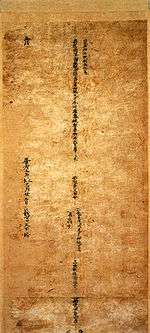 |
| Letter from the viceroy of Portuguese India (ポルトガル国印度副王信書 porutogaru kokuindo fukuō shinsho)[24][25] | Duarte de Menezes | Letter from Duarte de Menezes, viceroy of Portuguese India to daimyo Toyotomi Hideyoshi concerning the suppression of Christians in Japan | Azuchi-Momoyama period, April 1588 | one single sheet letter, ink on paper, 60.8 cm × 76.4 cm (23.9 in × 30.1 in) | Myōhō-in (妙法院), Kyoto | 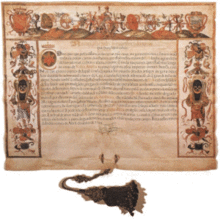 |
| etchū kuni kansō nōkoku kōtaiki zankan (越中国官倉納穀交替記残巻)[26][27] | — |
Agricultural records of villages in the Tonami District (礪波郡) of Etchū Province. It is a valuable resource for the study of an area under the Ritsuryō law in the 8th to 10th century. | Nara period and Heian Period, 751–901 | one rolled scroll | Ishiyama-dera, Ōtsu, Shiga | — |
| Documents related to the priest Enchin (円珍関係文書 enchin kankei monjo)[28][29][30] | Enchin and others | Documents[nb 5] surrounding Enchin's trip to China (953–958) containing information on his activities as well as on Sino-Japanese relations in the mid-9th century. They are also of interest for the study of calligraphy. | Heian Period and Tang Dynasty, 9th–10th century | eight rolled scrolls, ink on paper | Tokyo National Museum, Tokyo |  |
| Imperial Decree Granting Ecclesiastical Rank of Hōin Daikashō and Posthumous Name Chishō Daishi to Enchin (円珍贈法印大和尚位並智証大師諡号勅書 enchin zō hōin daikashō inarabini chishō daishi shigō chokusho)[31][32] | Ono no Michikaze (transcription), Fujiwara Hirofumi (composer) | Letter promoting Enchin, the teacher of Zōmyō, abbot of Enryaku-ji, 36 years after his death to the highest ecclesiastical rank: Great Master of the Dharma Seal (Hōin Daikashō) and granting the posthumous name: hishō Daishi | Heian period, December 27, 927 | rolled scroll, ink on decorative paper, 28.7 cm × 156.9 cm (11.3 in × 61.8 in) | Tokyo National Museum, Tokyo |  |
| Map of Nukata-dera garan and its vicinity (額田寺伽藍並条里図 Nukata-dera garan narabini jōri-zu)[33] | — |
A map showing a Shōen or manor in the Nara period. The depicted area is about 1,100m (NS) by 700m (EW). | Nara period, second half of 8th century | four linen cloths which together form a 2x2 map of 113.7 cm × 72.5 cm (44.8 in × 28.5 in) | National Museum of Japanese History, Sakura, Chiba |  |
| Name list of Abhiseka initiates (灌頂歴名 kanjō rekimyō) or List of individuals admitted into the mysteries of Shingon Buddhism[32][nb 6] | Kūkai | List of people and deities who underwent the Abhiseka ritual at Takaosan-ji (高雄山寺) (now Jingo-ji) in 812, presided by Kūkai | Heian period, 812 | rolled scroll, ink on paper, 29.0 cm × 268.4 cm (11.4 in × 105.7 in) | Jingo-ji, Kyoto |  |
| Official Register and Inventory for Kanshin-ji (観心寺縁起資財帳 Kanshin-ji engi shizaichō)[34] | — |
Document containing the reason and circumstances of the establishment of Kanshin-ji temple and a list of the temple's assets from that time | Heian period, September 15, 883 | one rolled scroll | Kanshin-ji, Kawachinagano, Osaka |  |
| Inventory of Kanzeon-ji (観世音寺資財帳 kanzeonji shizaichō)[35] | — |
Inventory of Kanzeon-ji | Heian period, October 1, 905 | three rolled scrolls, ink on paper: 29.0 cm × 581.5 cm (11.4 in × 228.9 in), 29.0 cm × 936.0 cm (11.4 in × 368.5 in), 29.0 cm × 682.5 cm (11.4 in × 268.7 in) | Tokyo University of the Arts, Tokyo | 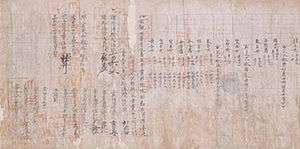 |
| Draft of the petition of foundation of Zenrin-ji by Emperor Kameyama (亀山天皇宸翰禅林寺御起願文案 Kameyama-tennō shinkan zenrinji gokigan mon'an)[nb 7] | Emperor Kameyama | Document on the foundation of Nanzen-ji, formerly Zenrin-ji (禅林寺) | Kamakura period, March 5, 1299 | one rolled scroll | Nanzen-ji, Kyoto | — |
| Visit of the cloistered Emperor to Kumano (熊野御幸記 kumano gokōki)[36] | Fujiwara no Teika | Diary in classical Chinese of a visit with Emperor Go-Toba and Minamoto no Michichika to Kumano (熊野) | Kamakura period, October, 1201 | one rolled scroll, ink on paper, 30.1 cm × 678.0 cm (11.9 in × 266.9 in) | Mitsui Memorial Museum, Tokyo | 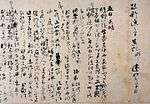 |
| Diary of ex-Emperor Go-Uda (後宇多院宸記 Go-Uda-in shinki)[37] | Emperor Go-Uda | Chronicle in the guchūreki (具注暦) almanac in the emperor's own handwriting | Kamakura period, 1319 | one rolled scroll | National Museum of Japanese History, Sakura, Chiba |  |
| Will with Handprints by Emperor Go-Uda (後宇多天皇宸翰御手印遺告 Go-Uda-tennō shinkan gotein yuigō)[38][39] | Emperor Go-Uda | Testament of Emperor Go-Uda with handprints | Kamakura period, 1308 | one rolled scroll, ink on paper, 54.5 cm × 788.8 cm (21.5 in × 310.6 in) | Daikaku-ji, Kyoto |  |
| Letter accompanying a prayer for the prosperity of Tō-ji temple, by Emperor Go-Uda (後宇多天皇宸翰東寺興隆条々事書御添状 Go-Uda-tennō shinkan Tō-ji kōryūjōjō kotogaki onsōjō)[40] | Emperor Go-Uda | Imperial letter praying for the growth of Tō-ji temple, written in the emperor's own handwriting one year after entering the priesthood | Kamakura period, February 12, 1308 | one rolled scroll | Tō-ji, Kyoto | — |
| Letter of the Emperor Go-Uda, Promotion of the precepts of the Daigo school (後宇多天皇宸翰当流紹隆教誡 Go-Uda-tennō shinkan tōryū shōryū kyōkai)[41] | Emperor Go-Uda | Three letters in the emperor's own handwriting addressed to a monk of Hōon-in (報恩院), Daigo-ji, with the intention of unifying the Ono (小野) and Hirosawa (広沢) branches of the Shingon sect | Kamakura period, 1309 | three letters mounted on a rolled scroll, 32.8 cm × 347.2 cm (12.9 in × 136.7 in) | Daigo-ji, Kyoto | — |
| Model letter by Emperor Go-Saga (後嵯峨天皇宸翰御消息 Go-Saga-tennō shinkan go-shōsoku)[42] | Emperor Go-Saga | Only extant letter of Emperor Go-Saga, addressed to the cloistered Prince Doshin of Ninna-ji | Kamakura period, April 15, 1246 | one hanging scroll | Ninna-ji, Kyoto |  |
| Testament by Emperor Go-Daigo (後醍醐天皇宸翰御置文 Go-Daigo-tennō shinkan go-okibumi) | Emperor Go-Daigo | Will in the emperor's own handwriting | Kamakura period, August 24, 1333 | one hanging scroll | Daitoku-ji, Kyoto | — |
| Tenchō injin (後醍醐天皇宸翰天長印信 Go-Daigo-tennō shinkan tenchō injin)[43] | transcription by Emperor Go-Daigo | Certificate of highest confirmation in Esoteric Buddhism given by the priest Kūkai to his disciple Shinga | Nanboku-chō period, June 16, 1339 | one rolled scroll, ink on decorated paper, 32.0 cm × 122.2 cm (12.6 in × 48.1 in) | Daigo-ji, Kyoto | — |
| Will and testament of Emperor Go-Toba with handprint (後鳥羽天皇宸翰御手印置文 Go-Toba-tennō shinkan gotein okibumi) | Emperor Go-Toba | Will and testament in the emperor's own handwriting with handprints | Kamakura period, February 9, 1239 | one hanging scroll | Minase Shrine, Shimamoto, Osaka |  |
| Moromichi Diary (後二条殿記 Go-Nijō donoki) | Fujiwara no Moromichi (also known as Go-Nijō Dono) and Fujiwara no Yorinaga (transcription) | Diary of Fujiwara no Moromichi consisting of one volume in his own handwriting covering parts of the year 1093 and 29 volumes transcribed by Fujiwara no Yorinaga | late Heian period, 1083–1099 | 30 rolled scrolls | Yōmei Bunko, Kyoto | — |
| Diary of Fujiwara no Michinaga (御堂関白記 Midō Kanpakuki)[nb 8][44] | Fujiwara no Michinaga | Diary of Fujiwara no Michinaga consisting of 14 volumes in his own handwriting and 12 other volumes. It covers the years from 998 to 1021 with interruptions. | Heian period, 998–1021 | 26 rolled scrolls, ink on paper | Yōmei Bunko, Kyoto | 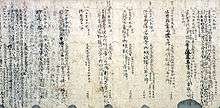 |
| History and Legends of the Kōryū-ji temple (広隆寺縁起資財帳 kōryū-ji engi shizai chō)[45] | — |
Catalogue of treasures and historical record of Kōryū-ji | Heian period | one rolled scroll | Kōryū-ji, Kyoto | — |
| Kōryū-ji shizai kōtai jitsuroku chō (広隆寺資財交替実録帳) | — |
Authentic register of property changes of Kōryū-ji temple | Heian period | one rolled scroll | Kōryū-ji, Kyoto | — |
| Catalogue of imported items (弘法大師請来目録 Kōbō Daishi shōrai mokuroku)[32][46][nb 9] | Saichō | Catalogue of articles brought back to Japan by Kūkai from his trip to Tang Dynasty China | Heian period, 9th century | one rolled scroll, ink on paper, 27.0 cm × 885.0 cm (10.6 in × 348.4 in) | Tō-ji, Kyoto |  |
| Three letters by Kūkai (弘法大師筆尺牘三通 Kōbō Daishi hitsu sekitoku santsū) (Fūshinjō (風信帖))[32][47][nb 10] | Kūkai | Three letters from Kūkai to Saichō mounted as a scroll | Heian period, 9th century | one rolled scroll, ink on paper, 28.8 cm × 157.9 cm (11.3 in × 62.2 in) | Tō-ji, Kyoto | 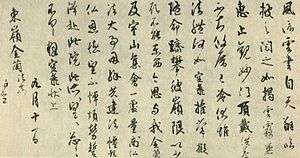
|
| Model letter by Emperor Takakura (高倉天皇宸翰御消息 Takakura tennō shinkan goshōsoku)[42][nb 11] | Emperor Takakura | Only extant letter of Emperor Takakura | Heian period, November 13, 1178 | one hanging scroll | Ninna-ji, Kyoto | 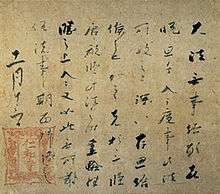 |
| Ordination certificate of monk Kōjō (嵯峨天皇宸翰光定戒牒 Saga tennō shinkan kōjō kaichō)[32][48] | Emperor Saga | Document in the emperor's own handwriting to the priest Kōjō (光定), after his vow to follow the precepts, certifying that Kōjō had undergone the rite known as Bosatsu-kai | Heian period, April 14, 823 | one rolled scroll, ink on paper, 37.0 cm × 148.0 cm (14.6 in × 58.3 in) | Enryaku-ji, Ōtsu, Shiga | |
| Imperial letters of three rulers (三朝宸翰 sanchō shinkan)[49] | Emperor Hanazono, Emperor Fushimi, Emperor Go-Daigo | — |
Kamakura period, 13th and 14th century | two rolled scrolls; 1st scroll: twelve letters by Emperor Hanazono, 2nd scroll: ten letters by Emperor Go-Daigo and two letters by Emperor Fushimi | Maeda Ikutokukai, Tokyo | — |
| Testament of the priest Jie (慈恵大師自筆遺告 jie daishi jihitsu yuigō) | Ryōgen (Jie Daishi) | Written by the 61-year-old priest Ryōgen, entrusting everything to his pupil Jinzen (尋禅). Contains detailed instructions on the funeral service | Heian period, May, 972 | one rolled scroll | Rozan-ji (廬山寺), Kyoto |  |
| Fragment of a census from 908 in Kuga, Kuga District, Suō Province (周防国玖珂郡玖珂郷延喜八年戸籍残巻 suō-no-kuni kugagun kugagō engi hachinen kosekizankan)[50] | — |
Family register of Kuga, Yamaguchi from 908 | Heian period, 908 | one rolled scroll | Ishiyama-dera, Ōtsu, Shiga |  |
| Uesugi Family documents (上杉家文書 uesugi-ke monjo)[nb 12][51] | — |
Collection of documents handed down in the Uesugi clan | Kamakura period – Edo period | bundle/batch of 2018 letters, 4 bound books and 26 bound double-leaved (袋とじ fukuro-toji) books | Yonezawa City Uesugi Museum, Yonezawa, Yamagata |  |
| True record of articles in the possession of Ninna-ji (仁和寺御室御物実録 Ninna-ji omuro gyobutsu jitsuroku)[52] | — |
Catalogue of items offered to the temple treasures by Emperor Uda about ten days before his death | Heian period, January 10, 950 | one rolled scroll | Ninna-ji, Kyoto | — |
| Suisaki (水左記) | Minamoto no Toshifusa | Diary of Sadaijin Minamoto no Toshifusa in his own handwriting | Heian period, 1077 and 1081 | two rolled scrolls: one for 1077, one for 1081 | Maeda Ikutokukai, Tokyo | — |
| Imperial rescript of Emperor Shōmu (聖武天皇勅書 Shōmu Tennō chokusho)[32] | Emperor Shōmu | — |
Nara period, May 20, 749 | one rolled scroll, ink on paper, 29.2 cm × 95.8 cm (11.5 in × 37.7 in) | Heiden-ji (平田寺), Makinohara, Shizuoka |  |
| Origin and history of Ghost Festival at Seigan-ji (誓願寺盂蘭盆縁起 Seigan-ji urabon engi)[53][nb 13] | Eisai | Document on the origin and meaning of the Ghost Festival as transmitted from Song Dynasty China | Heian period, July 15, 1178 | one rolled scroll, ink on colored paper, 35.3 cm × 154 cm (13.9 in × 60.6 in) | Seigan-ji (誓願寺), Fukuoka, Fukuoka |  |
| Letter soliciting donations for the restoration of Sennyū-ji temple (泉涌寺勧縁疏 Sennyū-ji kanenso)[32] | Shunjō | Document on the origins of Sennyū-ji temple | Kamakura period, October 1221 | one rolled scroll, ink on paper, 40.6 cm × 296.0 cm (16.0 in × 116.5 in) | Sennyū-ji, Kyoto | 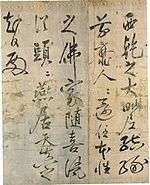 |
| Surviving passages of memorial presented to Emperor Saga (狸毛筆奉献表 Rimōhitsu hōkenhyō)[54][55] | Kūkai | Document accompanying the present of four Tanuki hair writing brushes to Emperor Saga. According to this document, the brushes were meant to be used for regular, semi-cursive, cursive script and for the hand-copying of sutras respectively. | Heian period | one rolled scroll, 27.6 cm × 65.8 cm (10.9 in × 25.9 in) | Daigo-ji, Kyoto | |
| Writings related to the priest Enchin (智証大師関係文書典籍 chishō daishi kankei monjo tenseki)[56] | — |
Various documents[nb 14] | Tang Dynasty, Heian period | various | Mii-dera, Ōtsu, Shiga |  |
| Essential Teachings for Tendai Lotus Sect Priests (天台法華宗年分縁起 tendai hokkeshū nenbun engi)[32][58] | attributed to Saichō | Letter addressed to the Imperial Court wishing for an increase of the number of people allowed to enter the priesthood from 10 to 12 per year due to the establishment of Tendai Buddhism | Heian period, 9th century | one rolled scroll, ink on paper, 28.9 cm × 340.3 cm (11.4 in × 134.0 in) | Enryaku-ji, Ōtsu, Shiga | 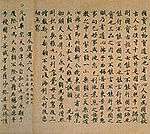 |
| Catalogue of Imported Items (伝教大師将来目録 Dengyō-daishi shōrai mokuroku) | Saichō | Catalogue of sacred books brought back by Saichō from Tang Dynasty China | Heian period, May 13, 805 | one rolled scroll | Enryaku-ji, Ōtsu, Shiga |  |
| Certificate of priesthood for Saichō and related papers to and from the controller of priesthood (伝教大師度縁案並僧綱牒 Dengyō-daishi Doen-an narabini Sōgō Chō)[59] | — |
Three letters on Saichō entering priesthood and his vow to follow the precepts | Nara period, 780–783 | one rolled scroll | Raigō-in (来迎院), Kyoto (Sakyō-ku) |  |
| Passing permits for Dengyō-daishi (伝教大師入唐牒 Dengyō-daishi nittōchō) | — |
Tang Dynasty passing permits for Saichō: from Ningbo in 804 and from Taizhou in 805 | Tang Dynasty, September 12, 804 and February 805 | one rolled scroll, 39.7 cm × 134.2 cm (15.6 in × 52.8 in) | Enryaku-ji, Ōtsu, Shiga | 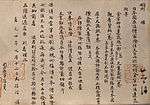 |
| Letter penned by the Saichō monk (伝教大師筆尺牘 Dengyō daishi hitsu sekitoku)[60][61] | Saichō | Letter known as Kykaku-jō (久隔帖) from Saichō to Taihan (泰範), his favourite student at Takaosan-ji (高雄山寺) (now Jingo-ji) | Heian period, November 25, 813 | one hanging scroll, 29.2 cm × 55.2 cm (11.5 in × 21.7 in) | Nara National Museum, Nara |  |
| Letter written in kana syllabary (伝藤原行成筆仮名消息 denfujiwara no Yukinari hitsu kana shōsoku) | attributed to Fujiwara no Yukinari | Letter valued for its continuous unbroken calligraphy | Heian period, 10th–11th century | one hanging scroll, 28.2 cm × 420.0 cm (11.1 in × 165.4 in) | Kyūkyodō (鳩居堂), Kyoto | 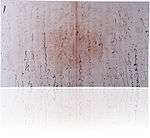 |
| Documents and treasures of Tō-ji (東寺百合文書 Tō-ji hyakugō monjo)[62][nb 15] | — |
Huge collection of documents covering a lot of ground starting from Shōen or manor related documents and including documents on the economic history and the history of Buddhism | 8th century Nara period – late Edo period | bundle/batch of 24,067 items including 3,863 rolled scrolls, 1172 bound double-leaved (袋とじ fukuro-toji) books, six bound books, 67 hanging scrolls, 13,695 single-sheet letters | Kyoto Prefectural Library and Archives (京都府立総合資料館), Kyoto | 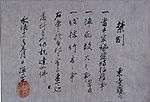 |
| Documents of Tōdai-ji (東大寺文書 Tōdai-ji monjo) | — |
Collection of documents on the history of Tōdai-ji temple | Heian period – Muromachi period | 100 rolled scrolls (with 979 mounted letters), 8,516 single-sheet letters | Tōdai-ji, Nara | 
|
| Letter by Fujiwara no Sari (藤原佐理筆書状 Fujiwara no Sari hitsu shojō) or Riraku-jō (離洛帖)[63][nb 16] | Fujiwara no Sukemasa/Sari | Written from Shimonoseki on the way to Kyushu where Sasaki had been appointed Dazai no Daini (太宰大弐) (Assistant secretary of Dazaifu Province). Addressed to Fujiwara no Sanenobu (藤原誠信). | Heian period, 991 | one hanging scroll, ink on paper, 64.6 cm × 31.7 cm (25.4 in × 12.5 in) | Hatakeyama Memorial Museum of Fine Art, Tokyo | 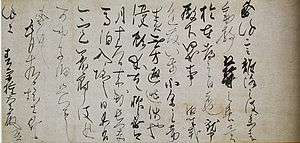 |
| Draft Letters by Fujiwara no Tadamichi (藤原忠通筆書状案 Fujiwara no Tadamichi hitsushojōan)[64] | Fujiwara no Tadamichi | Collection of 25 letters composed as a style manual for letter writing | Heian period, 12th century | one hanging scroll, ink on paper, 31.2 cm × 980.3 cm (12.3 in × 385.9 in) | Kyoto National Museum, Kyoto | 
|
| Stone in Nasu County (那須国造碑 nasu kokuzō hi)[65][66] | — |
Granite stone monument in remembrance of Atai Ide, governor of Nasu, consisting of a standing main stone with a hat stone. The main stone bears a calligraphic inscription (8 lines of 19 characters) which is influenced by the Northern Wei robust style. | Asuka period, end of the 7th century | inscription on stone, height without hat stone: 120 cm (47 in), width: 43.5–48 cm (17.1–18.9 in), hat stone 51 cm x 51 cm x 30 cm (20.1 in x 20.1 in x 11.8 in) | Kasaishi Shrine (笠石神社 kasaishi jinja), Ōtawara, Tochigi | |
| Ennin's Diary: The Record of a Pilgrimage to China in Search of the Law (入唐求法巡礼行記 nittō guhō junreikōki)[67] | Kanetane (兼胤) (transcription of the original by Ennin) | Transcription of the 9th century original (lost) by Kanetane, a monk at Chōraku-ji (長楽寺), Kyoto | Kamakura period, October 26, 1291 (post scriptum) | four bound books | private (Andō Sekisan Gōshi Company (安藤積産合資会社 andō sekisan gōshi gaisha)), Motosu, Gifu | 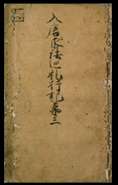 |
| Certificate of advanced learning in Buddhism (附法状 Fuhōjō)[68] | Shunjō | Written by the priest Shunjō in the last month before his death for his student Shinkai (心海) | Kamakura period, March 22, 1227 | one hanging scroll | Sennyū-ji, Kyoto | — |
| Priest Mongaku's forty-five article rules and regulations (文覚四十五箇条起請文 mongaku yonjūgokajō kishōmon〉)[69][70][71] | Fujiwara no Tadachika | Document requesting the restoration of Jingo-ji temple from Emperor Go-Shirakawa | early Kamakura period, before 1192 | one rolled scroll with handprints | Jingo-ji, Kyoto | 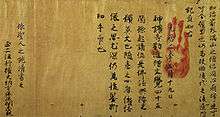 |
| hōkanshū (宝簡集), zoku hōkanshū (続宝簡集), yūzoku hōkanshū (又続宝簡集) | — |
Documents on the history, territory, function, etc. of Mount Kōya including letters by Minamoto no Yoritomo, Minamoto no Yoshitsune and Saigyō Hōshi | Heian period – Azuchi-Momoyama period | bundle/batch of 54/77/167 rolled scrolls and 0/6/9 bound double-leaved (袋とじ fukuro-toji) books | Kongōbu-ji, Kōya, Wakayama | |
| Record of Imperial Bequest to the Hōryū-ji temple (法隆寺献物帳 hōryūji kenmotsu chō)[72] | Fujiwara no Nakamaro, Fujiwara Nagate, Koma Fukushin, Kamo Tsunotari and Kazuragi Henushi | Record of the objects bequeathed to the Hōryū-ji temple by Empress Kōken on occasion of the death of Emperor Shōmu | Nara period, July 8, 756 | one rolled scroll, ink on paper 27.8 cm × 70.6 cm (10.9 in × 27.8 in) | Tokyo National Museum, Tokyo |  |
| The Record of the Clear Moon (明月記 meigetsuki)[73][nb 17] | Fujiwara no Teika | Comprehensive diary in classical Chinese, covering the life of the author from age 18 to his death. | Kamakura Period, ca. 1180–1241 | 58 rolled scrolls and one hanging scroll | Reizei-ke Shiguretei Bunko (冷泉家時雨亭文庫), Kyoto and private collection |  |
| Letter of dismissal by Rigen Daishi (理源大師筆処分状 rigen daishi hitsu shobunshō)[74] | Rigen Daishi (理源大師) | Written by the priest and founder of Daigo-ji Rigen Daishi (Shōbō (聖宝)) | Heian period, June 2, 907 | one rolled scroll, 31.8 cm × 45.0 cm (12.5 in × 17.7 in) | Daigo-ji, Kyoto | — |
| List of Ritual Implements of Esoteric Buddhism and other objects brought back by the Priest Saichō (羯磨金剛目録 katsuma kongō mokuroku)[75] | Saichō | An inventory of 66 items that Saichō brought back from China and stored at Hiezan in 805 | Heian period, July 17, 811 | one rolled scroll, 27.9 cm × 37.0 cm (11.0 in × 14.6 in) | Enryaku-ji, Ōtsu, Shiga | 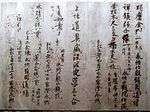 |
| Epistle to Zhongfeng Mingben (与中峰明本尺牘 yochūhō myōhon sekitoku)[76][77] | Zhao Mengfu | Letters to the priest Zhongfeng Mingben (Chung Feng Ming Pen) in the style of Wang Xizhi expressing Zhao Mengfu's deep love and respect to Zhongfeng | Yuan Dynasty, 14th century | one bound book with six letters, ink on paper, 35.1 cm × 22.1 cm (13.8 in × 8.7 in),... | Seikadō Bunko Art Museum, Tokyo | 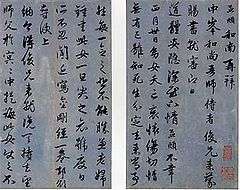 |
| Map of rice fields in Naruto, Imizu District, Etchū Province (越中国射水郡鳴戸村墾田図 Etchū no kuni imizu-gun naruto-mura konden-zu)[78] | — |
Map of rice fields in Naruto (today central Takaoka), a former manor of Tōdai-ji. The map had been in the possession of Tōdai-ji. | Nara period, 759 | unbound, ink and light color on linen cloth, 79.8 cm × 140.5 cm (31.4 in × 55.3 in) | Nara National Museum, Nara, Nara |  |
See also
- Nara Research Institute for Cultural Properties
- Tokyo Research Institute for Cultural Properties
- Independent Administrative Institution National Museum
Notes
- ↑ Probably much before this date.
- ↑ Only the oldest period is counted, if a National Treasure consists of items from more than one period.
- ↑ 33 document boxes are attached to the nomination.
- ↑ A survey document (海部氏勘注系図) of one rolled scroll is attached to the nomination.
- ↑ The eight rolled scrolls are:
- Letter written by Enchin (円珍自筆書状 enchin jihitsu shojō), 31.2–56.1 cm (12.3–22.1 in)
- Enchin's ordination Document (円珍戒牒 enchin kaichō), 29.3–192.0 cm (11.5–75.6 in)
- Document Issued by the Ministry of Civil Administration Notifying the Appointment of Enchin as Attendant Monk (円珍充内供奉治部省牒 enchin jūnai gubu jibu shōchō), 29.4–139.1 cm (11.6–54.8 in)
- Certificate Issued by Government Headquarters in Dazaifu for Enchin (円珍大宰府公験 enchin dazaifu kugen), 31.2–56.1 cm (12.3–22.1 in), 27.8–39.3 cm (10.9–15.5 in)
- Certificates Issued by Fuzhou for Enchin (円珍福州公験 enchin fukushū kugen), 31.2–56.1 cm (12.3–22.1 in), 30.5–134.0 cm (12.0–52.8 in)
- Official Documents Issued by Taizhou and Wenzhou (円珍台州温州公験 enchin taishū unshū kugen), 30.0–338 cm (11.8–133.1 in)
- Official Request from Sanuki Province (讃岐国司解 sanuki no kokushinoge), 30.3–266 cm (11.9–104.7 in)
- Request from the Ōtomo Clan (大友氏屈請 ōtomoshi kusshō), 29.6–48.4 cm (11.7–19.1 in)
- ↑ A one rolled scroll imperial letter by Emperor Go-Uda on the endowment of temple properties is attached to the nomination.
- ↑ One bound registration book (南禅寺領諸国所々紛失御判物帖) is attached to the nomination.
- ↑ Attached to the nomination are an excerpt of the history of an enshrinement hall (御堂御記抄) consisting of five rolled scrolls and one hanging scroll; and an inventory of an enshrinement hall (御堂御暦記目録) consisting of one single-sheet letter.
- ↑ Attached to the nomination is a donation letter from June 21, 1341.
- ↑ Attached to the nomination are a donation and an escort letter.
- ↑ Attached to the nomination is one hanging scroll of a letter by Shukaku Hosshinnō (守覚法親王)
- ↑ Attached to the nomination are 325 bound double-leaved (袋とじ fukuro-toji) books or fourteen copies of a chronological record of successive generations and three covered containers.
- ↑ One rolled scroll, Origin and history of the construction of Seigan-ji (誓願寺建立縁起 seigan-ji kenritsu engi) is attached to the nomination.
- ↑
- Six documents related to his secular surname (family tree) and priestly rank
- Five documents related to his trip to China (peaceful prayer and correspondence)
- Five catalogues of sacred books and sutras obteined in China
- Ten documents related to teaching Buddhism
- Eight sacred books collected in China
- Three documents in his own handwriting
- Nine dated and signed messages
- ↑ Attached to the nomination are 94 document boxes donated by Maeda Tsunanori in 1685.
- ↑ Attached to the nomination is one hanging scroll by Konoe Iehiro.
- ↑ Attached to the nomination are one scroll of a supplementary manuscript, and 10 pages of the former binding mounted on one rolled scroll.
References
- ↑ Coaldrake, William Howard (2002) [1996]. Architecture and authority in Japan. London, New York: Routledge. p. 248. ISBN 0-415-05754-X.
- ↑ Enders & Gutschow 1998, p. 12
- ↑ "Cultural Properties for Future Generations" (PDF). Tokyo, Japan: Agency for Cultural Affairs, Cultural Properties Department. March 2011. Retrieved 2011-06-06.
- 1 2 3 国指定文化財 データベース [Database of National Cultural Properties] (in Japanese). Agency for Cultural Affairs. 2008-11-01. Retrieved 2009-04-16.
- 1 2 3 Seeley 1991, p. 9
- ↑ Seeley 1991, p. 10
- ↑ Seeley 1991, p. 11
- ↑ Seeley 1991, p. 12
- ↑ Seeley 1991, p. 13
- 1 2 3 4 Seeley 1991, p. 6
- 1 2 Keally, Charles T. (2009-06-14). "Historic Archaeological Periods in Japan". Japanese Archaeology. Charles T. Keally. Retrieved 2010-09-09.
- ↑ Seeley 1991, p. 16
- ↑ Seeley 1991, p. 17
- ↑ Seeley 1991, p. 24
- ↑ Seeley 1991, p. 23
- ↑ Seeley 1991, p. 8
- ↑ Sakamoto 1991, p. 3
- 1 2 3 4 5 Seeley 1991, p. 40
- ↑ Seeley 1991, p. 41
- ↑ Seeley 1991, p. 55
- ↑ "The University of Tokyo Library System Bulletin Vol 42, No 4" (PDF). Tokyo University library. September 2003. Retrieved 2010-01-03.
- ↑ "Special Exhibition – The Sacred World of Shinto Art in Kyoto, Images from the Exhibit, Section II Shinto History and Section III Festivals in Kyoto". Kyoto National Museum. Retrieved 2009-04-30.
- ↑ 海部氏系図 [Genealogy of the Amabe Clan] (in Japanese). Kono Shrine. Retrieved 2010-01-03.
- ↑ A Carta do Vice-Rei D. Duarte de Menezes a Toyotomi Hideyoshi, 1588. [Letter from the viceroy D. Duarte de Menezes to Toyotomi Hideyoshi, 1588.]. Colecção Fundação Cidade de Lisboa (in Portuguese). Open Library. Retrieved 2009-04-28.
- ↑ Commission for the protection of cultural properties; Mainichi Shimbun; National Treasure Commission (1968). 原色版国宝: 桃山・江戶・明治 [National Treasures in tricolor prints: Momoyama, Edo and Meiji periods]. National Treasures in tricolor prints, Commission for the protection of cultural properties (in Japanese). 12. Mainichi Shimbun. p. 136. Retrieved 2010-09-05.
- ↑ 越中国官倉納穀交替記残巻 [etchū kuni kansō nōkoku kōtaiki zankan] (in Japanese). Ōtsu City Museum of History. Retrieved 2009-04-28.
- ↑ Akihiro, Watanabe (1989-12-20). Fudokoku in the Heian Period. Shigaku zasshi. 98. The Historical Society of Japan. pp. 1891–1937. ISSN 0018-2478. Retrieved 2010-01-03.
- ↑ Tokyo National Museum. "Letter (Documents related to the priest Enchin).". Tokyo National Museum. Retrieved 2009-04-28.
- ↑ The Agency for Cultural Affairs. 円珍関係文書 文化遺産オンライン [Documents related to the priest Enchin, cultural heritage online] (in Japanese). Tokyo National Museum. Retrieved 2009-04-28.
- ↑ "Documents Related to Enchin" (in Japanese, Chinese, Korean, English, and French). Tokyo National Museum. 2004. Retrieved 2009-04-30.
- ↑ "Imperial Decree Granting Ecclesiastical Rank of Hōin Daikashō and Posthumous Name Chishō Daishi to Enchin" (in Japanese, Chinese, Korean, English, and French). Tokyo National Museum. 2004. Retrieved 2009-04-30.
- 1 2 3 4 5 6 7 8 "National Treasures of Japan – Exhibition catalogure, April 10 – May 27, 1990, Tokyo National Museum" (in Japanese). Yomiuri Shimbun. 1990.
- ↑ 額田寺伽藍並条里図 [Map of Nukata-dera garan and its vicinity] (in Japanese). National Museum of Japanese History. Retrieved 2009-05-11.
- ↑ 観心寺縁起資財帳 [Official Register and Inventory for Kanshinji] (in Japanese). Kawachinagano city. Retrieved 2009-04-30.
- ↑ 観世音寺資財帳 [Inventory of Kanzeon-ji] (in Japanese). Tokyo University of the Arts. Retrieved 2009-04-30.
- ↑ "Collection" (in Japanese). Mitsui Memorial Museum. Retrieved 2010-09-11.
- ↑ "The Function of Medieval Temples and Monasteries". REKIHAKU Special Exhibition 2002. National Museum of Japanese History. Retrieved 2011-06-06.
- ↑ "Treasures of Daikaku-ji Temple". Kyoto National Museum. 2009. Retrieved 2009-05-08.
- ↑ "Will with Handprints by Emperor Go-Uda" (in Japanese). Daikaku-ji. 2008. Retrieved 2009-05-08.
- ↑ "Thematic Exhibition – Imperial Calligraphy: Stylistic Developments in Emperors' Writings". Tokyo National Museum. 2009. Retrieved 2009-05-08.
- ↑ Kyoto National Museum (1983). 弘法大師と密教美術: 入定1150年 [Kobō Daishi and the Art of Esoteric Buddhism: 1150th anniversary of entering nirvana] (in Japanese). Asahi Shimbun. p. 259. Retrieved 2010-09-05.
- 1 2 "Calligraphy by Emperors: The Sentiment that Went into Imperial Letters". Kyoto National Museum. 2009. Retrieved 2009-05-08.
- ↑ Kyoto National Museum; Yomiuri Shimbun. Koku hō, Kyōtō Kokuritsu Hakubutsukan (in Japanese). OCLC 83735789. Retrieved 2009-12-31.
- ↑ "Special Exhibition – The Legacy of Fujiwara no Michinaga: Courtly Splendor and Pure Land Faith". Kyoto National Museum. Retrieved 2009-05-08.
- ↑ Sakamoto 1991, p. 30
- ↑ Peter Francis Kornicki (1998). The book in Japan: a cultural history from the beginnings to the nineteenth century. BRILL. p. 285. ISBN 90-04-10195-0. Retrieved 2009-05-08.
- ↑ 弘法大師筆尺牘三通 [Three letters by Kūkai] (in Japanese). Kochi Shimbun. Retrieved 2009-11-04.
- ↑ 嵯峨天皇宸翰光定戒牒 [Ordination certificate of monk Kōjō] (in Japanese). Otsu City Museum of History. Retrieved 2010-09-05.
- ↑ 前田家の名宝 [Treasures of the Maeda family] (in Japanese). Ishikawa Prefectural Museum of Art. Retrieved 2010-09-05.
- ↑ 周防国玖珂郡玖珂郷延喜八年戸籍残巻 [Fragment of a census from 908 in Kuga, Kuga District, Suō Province] (in Japanese). Otsu City Museum of History. Retrieved 2009-05-08.
- ↑ 上杉家文書 [Uesugi Family documents] (in Japanese). Yamagata. Retrieved 2010-01-07.
- ↑ Ishida, Mosaku (1964). Terry, Charles S., ed. Japanese Buddhist prints. H. N. Abrams. p. 13. Retrieved 2010-01-07.
- ↑ 博物館情報: 誓願寺盂蘭盆縁起 [Museum Information: Origin and history of Bon Festival at Seigan-ji] (in Japanese). Kyushu National Museum. Retrieved 2009-05-11.
- ↑ 狸毛筆奉献表 [Surviving passages of memorial presented to Emperor Saga]. lincs (in Japanese). Retrieved 2009-05-11.
- ↑ Yamasaki, Shigehisa (1981). Chronological table of Japanese art. Geishinsha. p. 454. Retrieved 2010-01-07.
- ↑ "Documents and books" (in Japanese). Mii-dera. Retrieved 2010-01-08.
- ↑ 智証大師関係文書典籍 [Writings related to the priest Enchin] (in Japanese). Otsu City Museum of History. Retrieved 2010-01-08.
- ↑ 特別展 最澄と天台の国宝 [Special exhibition: Saichō and Treasures of Tendai] (in Japanese). Tokyo National Museum. Retrieved 2010-09-03.
- ↑ Asahi Shimbun (1986). Hieizan to Tendai no bijutsu: Hieizan kaisō 1200-nen kinen (in Japanese). Asahi Shimbun. p. 413. Retrieved 2010-01-08.
- ↑ 伝教大師筆尺牘 (久隔帖) [Letter penned by Saichō (Kykaku-jō)] (in Japanese). Nara National Museum. Retrieved 2009-05-11.
- ↑ "Letter penned by the Saicho monk". emuseum (in Japanese, Chinese, Korean, English, and French). Tokyo National Museum. 2004. Retrieved 2010-09-11.
- ↑ 東寺百合文書 [Documents and treasures of Tō-ji] (in Japanese). Yokohama National University. Retrieved 2010-01-08.
- ↑ "Letter by Fujiwara no Sari". Collection (in Japanese). Hatakeyama Memorial Museum of Fine Art. Retrieved 2009-05-07.
- ↑ "Draft Letters". emuseum (in Japanese, Chinese, Korean, English, and French). Tokyo National Museum. 2004. Archived from the original on 2007-08-16.
- ↑ 那須国造碑 [Stone in Nasu County] (in Japanese). Ōtawara city. Retrieved 2010-01-08.
- ↑ 那須国造碑 [Stone in Nasu County] (in Japanese). Tochigi Prefecture. Retrieved 2010-01-08.
- ↑ 代表作品のご紹介 [Introduction to Masterpieces] (in Japanese). Tochigi Prefectural Museum. Retrieved 2010-01-08.
- ↑ Yamasaki, Shigehisa (1981). Chronological table of Japanese art. Geishinsha. p. 343. Retrieved 2010-01-07.
- ↑ "Special Exhibition – Bridging Tradition: The 110th Anniversary Exhibition of the Kyoto National Museum". Kyoto National Museum. 2009. Retrieved 2009-05-12.
- ↑ Kuroda, Toshio; Jacqueline I. Stone (trans.) (1996). "The Imperial Law and the Buddhist Law". Japanese Journal of Religious Studies. 23 (3–4). Cite uses deprecated parameter
|coauthors=(help) - ↑ 藤原忠親 [Fujiwara no Tadachika] (in Japanese). kotobank. Retrieved 2009-12-09.
- ↑ "Record of Imperial Bequest to the Hōryū-ji". emuseum (in Japanese, Chinese, Korean, English, and French). Tokyo National Museum. 2004. Retrieved 2010-09-11.
- ↑ Shimosaka, Mamoru; Melissa M. Rinne. "Meigetsuki (The Record of the Clear Moon)". Kyoto National Museum. Retrieved 2009-04-28.
- ↑ 日本の仏敎を築いた人びと: その肖像と書 [People who built Japanese Buddhism: portraits and writings] (in Japanese). Nara National Museum. 1981. p. 72. Retrieved 2010-09-04.
- ↑ 羯磨金剛目録 [List of Ritual Implements of Esoteric Buddhism and other objects brought back by the Priest Saichō] (in Japanese). Ōtsu City Museum of History. Retrieved 2010-09-04.
- ↑ 趙子昂書 (与中峰明本尺牘) [Zhao Mengfu (Epistle to Zhongfeng Mingben)] (in Japanese). Seikadō Bunko Art Museum. Retrieved 2011-05-08.
- ↑ "Epistle to Zhongfeng Mingben". Image Database. University of California. Retrieved 2009-05-01.
- ↑ 越 中国射水郡鳴戸村墾田図 [Map of rice fields in Naruto village, Imizu District, Etchū Province] (in Japanese). Nara National Museum. Retrieved 2010-07-02.
Bibliography
- Enders, Siegfried R. C. T.; Gutschow, Niels (1998). Hozon: Architectural and Urban Conservation in Japan (illustrated ed.). Edition Axel Menges. ISBN 3-930698-98-6.
- Lu, David John (1997). Japan: a documentary history. 1 (2, illustrated ed.). M. E. Sharpe. pp. 21–22. ISBN 1-56324-906-5.
- Sakamoto, Tarō (1991). The six national histories of Japan. UBC Press. ISBN 0-7748-0379-7.
- Seeley, Christopher (1991). A history of writing in Japan. Brill's Japanese studies library. 3 (illustrated ed.). BRILL. ISBN 90-04-09081-9.
| Wikimedia Commons has media related to National Treasure ancient documents. |

_(Todaiji).jpg)
